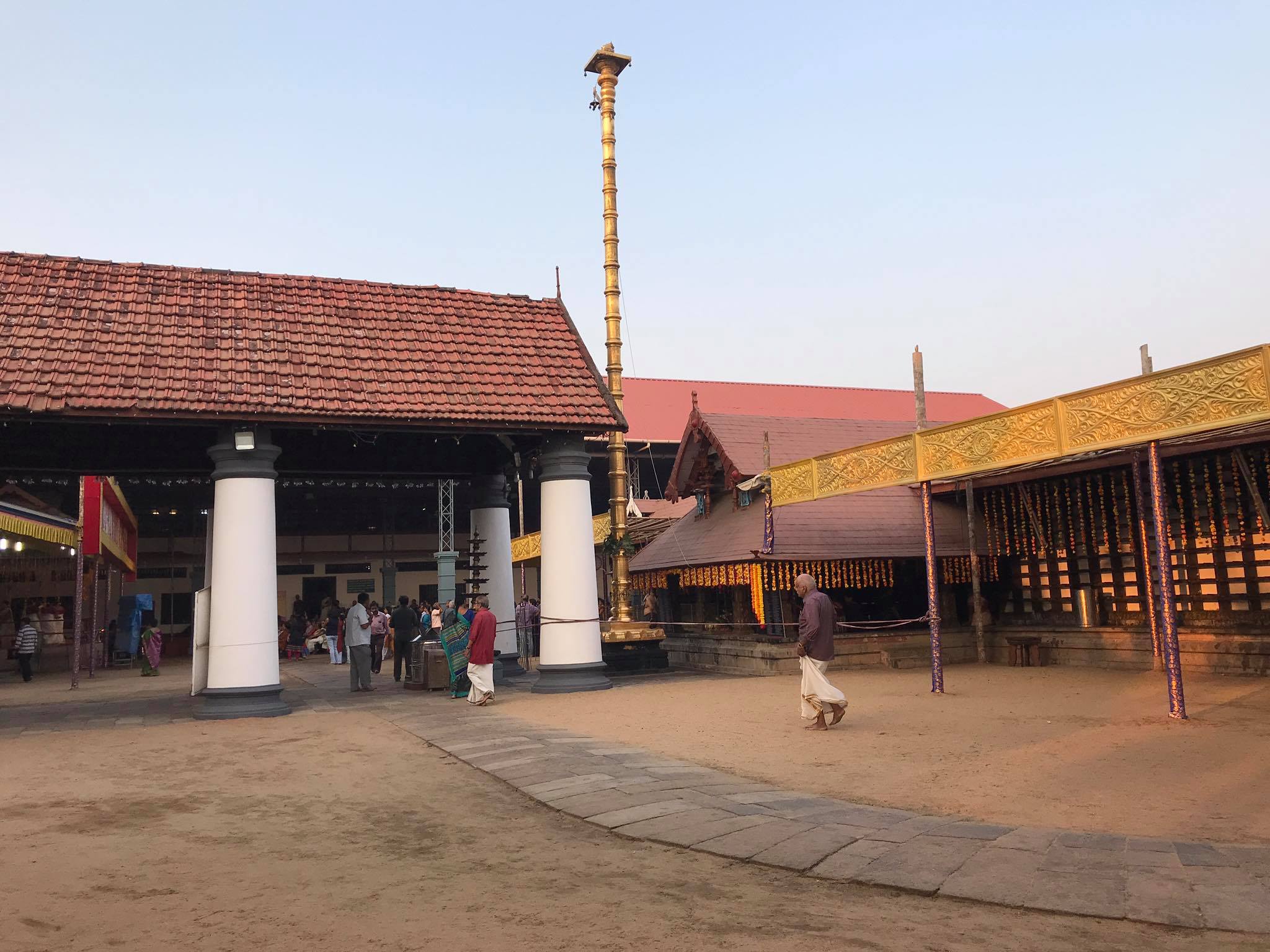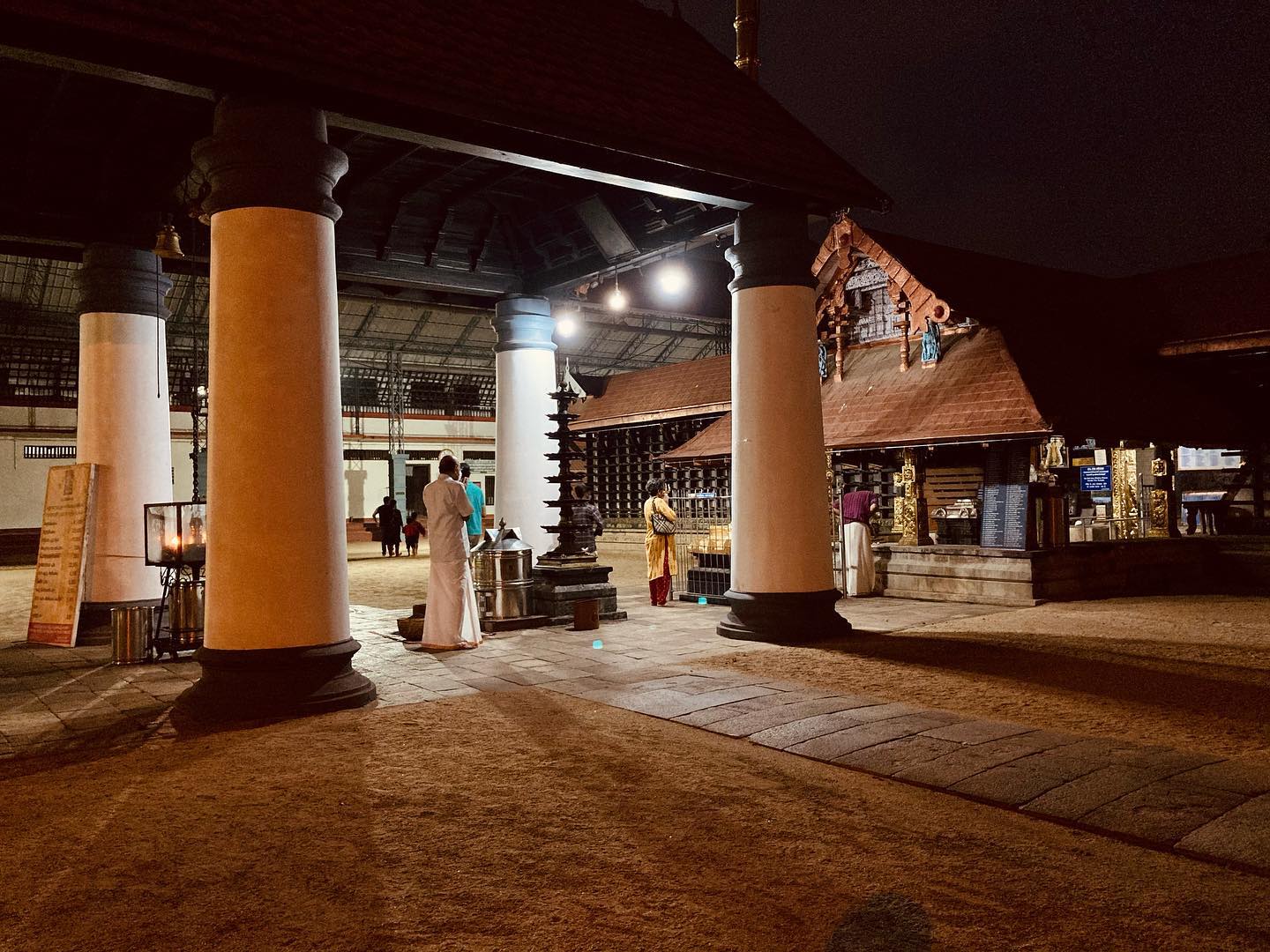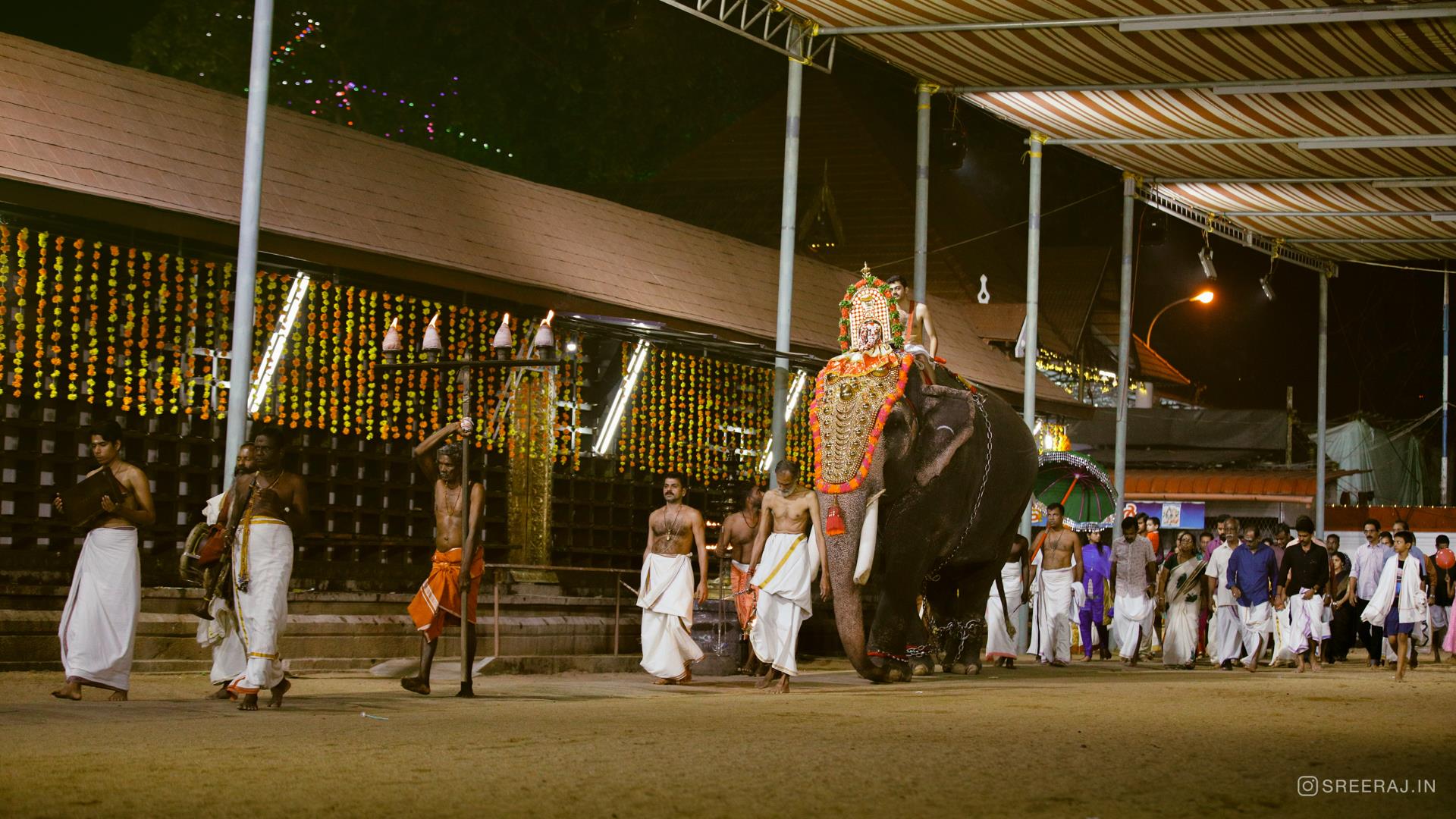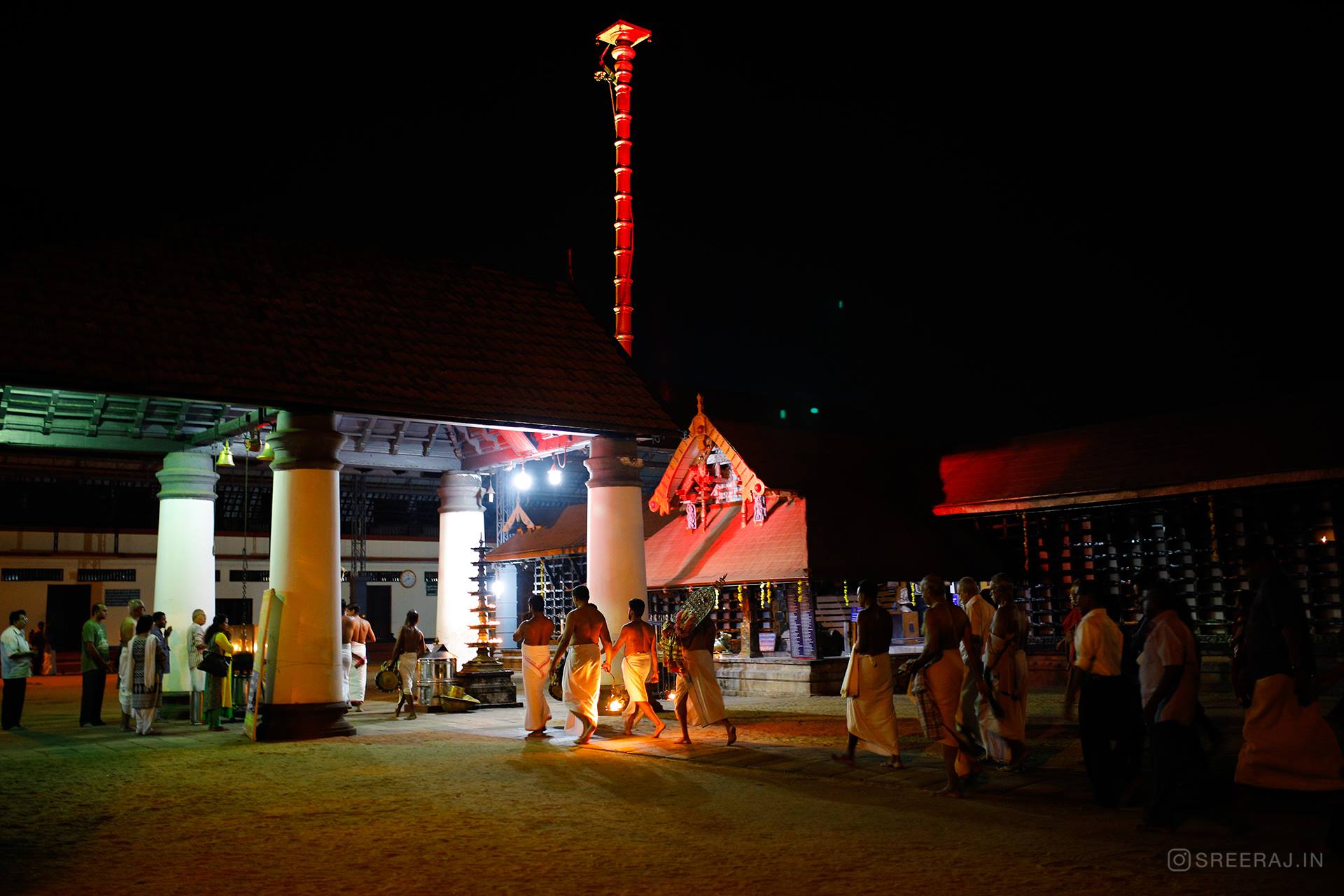Ernakulam Shiva Temple, also known as Ernakulathappan Temple, is one of the major temples in Kerala, located in the heart of Ernakulam, Kochi, India.

Dedicated to Lord Shiva, the temple is regarded as the city's protector, according to local Hindu beliefs and traditions. The deity is reverently called Ernakulathappan, meaning "Lord of Ernakulam."
Situated within the Durbar Hall Ground, the temple has a deep historical connection with the city and was one of the seven royal temples of the Kochi Maharajas. It is currently managed by the Cochin Devaswom Board. The present structure of the temple was built in 1846 under the patronage of Diwan Sri Edakkunni Sankara Warrier, elevating its status to that of a royal temple in the Kochi Kingdom.
Ernakulam Shiva Temple stands on a 1-acre (4,000 m²) site and is considered one of Kerala’s prominent Shiva temples, alongside the Ettumanoor Mahadevar Temple, Kaduthuruthy Mahadeva Temple, Vaikom Temple, Chengannur Mahadeva Temple, Vadakkunnathan Temple, and Sreekanteswaram Mahadeva Temple in Thiruvananthapuram. Ernakulam Shiva Temple, also known as Ernakulathappan Temple, was founded by the Cheranalloor Kartha Family of South Chittoor. According to a devaprasna (astrological temple inquiry), the temple has a connection with Vaishnavism. Jadavedan Namboothiri, a member of the Cheranalloor Kartha Family, served as the swamiyar (spiritual head) of both the Ernakulam Shiva Temple and the Thiruvananthapuram Shri Padmanabhaswamy Temple.
The temple’s origins are deeply rooted in the Hindu epic Mahabharata. It is believed that Arjuna, the third Pandava, performed intense penance to please Lord Shiva. Impressed by his devotion, Lord Shiva, accompanied by Goddess Parvati, left Mount Kailash to meet Arjuna. To test Arjuna’s dedication and impress Parvati, Shiva disguised himself as Kiratha, a tribal hunter.
As Shiva approached, a wild boar charged toward Arjuna. Both Arjuna and Kiratha shot arrows at the boar, which was actually the demon Mookasura in disguise. When the demon was slain, a dispute arose between Arjuna and Kiratha over who had struck the fatal blow. A fierce battle followed, in which Arjuna was ultimately defeated.
Exhausted and unable to stand, Arjuna crafted a Shiva Linga from mud and began worshiping it by offering flowers. To his astonishment, the flowers he placed on the Linga appeared on Kiratha’s head. Realizing that Kiratha was none other than Lord Shiva himself, Arjuna bowed in devotion. Pleased with his sincerity, Shiva granted him the powerful Pashupatastra (Pashupatha Arrow).
Over time, the site was forgotten and became overgrown with dense forest. The Shiva Linga that Arjuna had worshiped was buried in mud and lost from memory.
Centuries later, a sage named Devala, who had been cursed to have the body of a snake, wandered into the forest. He discovered the buried Linga and began worshiping it, hoping to be freed from his curse. The local people, frightened by his serpent-like form, called him Rishi Nagam (Saint Serpent) and tried to drive him away. However, he remained undisturbed and continued his severe penance.
Eventually, Lord Shiva and Goddess Parvati appeared before him and instructed him to bathe in a nearby pond. The moment he immersed himself in the water, he was freed from the curse. A new Shiva idol miraculously appeared near the original Linga.
The place was then named Rishnagakulam (meaning "The Pond of Rishi Nagam"), and a temple was built at the site.
This sacred legend highlights the divine significance of the Ernakulam Shiva Temple and its association with Lord Shiva’s blessings and the great warrior Arjuna. Ernakulam Shiva Temple was first mentioned in Sangam literature as one of the major temples under the Chera Dynasty, whose rulers were ardent devotees of Lord Shiva. After the fall of the Cheras, the temple came under the control of Nair nobles, who renamed the place as Ernakulam, a corrupt form of the original term Eere Naal Kulam, meaning "Pond with water always," in recognition of the temple’s sacred pond.
Later, the region came under the reign of the Kochi Kingdom, and during the 17th century, when the Dutch siege forced the Kochi rulers to shift their capital from Fort Kochi to Ernakulam, they established a palace near the temple, facing the temple pond (now known as the Tank Shed Palace behind the Durbar Hall). This royal patronage elevated the temple’s prominence, and the deity was declared the Nagara Devata (protector of the city). The second phase of the temple’s development came in 1842 when the Diwan of Kochi, Sri Edakkunni Sankara Warrier, initiated renovation works due to the temple’s deteriorating condition.
By 1843, two new Gopura Mandapams (entrance towers) were constructed in the traditional Kerala style, resembling those of the Sree Poornathrayeesa Temple in Tripunithura, the chief royal temple of the Kochi Maharajas. The newly renovated temple complex was opened to the public in 1846 and was elevated to the status of a royal temple, coming under the direct administration of the Kochi Government’s Devaswom Board. Following Kochi’s accession to the Indian Union in 1949, the temple’s administration was taken over by the state-controlled Devaswom Board, which continues to oversee it today.
The presiding deity of the Ernakulam Shiva Temple is Lord Shiva in the Gourisankara form, enshrined in the main sanctum sanctorum, facing west towards the Arabian Sea. The Lingam in the sanctum is considered Swayambhu (self-manifested). To the north of the sanctum, there is a small shrine dedicated to Kirthamoorthy, believed to be the original Lingam worshipped by Arjuna. On the southern side, a shrine is dedicated to Lord Ganesha, the son of Shiva. Behind the main sanctum, an area is revered as the shrine of Goddess Parvati, which is why the east gate is known as the Devi Gate. Outside the inner temple complex, shrines for Lord Ayyappa and Nagaraja are also present.
Spanning an area of 1.2 acres (4,900 m²), the temple is built in the traditional Kerala temple architectural style. The sanctum complex is circular, adorned with finely sculpted walls, and its roof is covered with copper tiles. The temple has two entrance towers (Gopurams): the western Gopuram is a two-storied structure featuring the distinct Kerala-style gabled roofs and slanting windows, while the eastern Gopuram has been recently renovated in a similar style. The Devaswom office is located near the western Gopuram. Additionally, a new marriage hall and an Oottupura (dining hall) have been constructed on the northern side of the temple premises.
Uthsavom (annual festival) of the Ernakulam Shiva Temple is one of the grandest and most vibrant celebrations in Kochi, typically held during the Malayalam month of Makaram. The festivities begin with the ceremonial Kodiyettam (flag hoisting) on the first evening, marking the formal commencement of the festival. The seventh day features the spectacular Pakalpooram, during which the deity is taken out in a majestic procession accompanied by richly adorned caparisoned elephants, resonating Panchavadyam, and culminating in a grand Pandimelam and dazzling fireworks at the Durbar Hall Ground.
On the final day, a solemn ritual is held in the evening where the temple flag is lowered. The deity is then taken for the traditional Arattu (holy bath) in the temple pond. Following the bath, the vibrant Arattu procession begins, again accompanied by Panchavadyam, and ends at the Durbar Hall Ground with a breathtaking fireworks display, bringing the week-long festival to a glorious close.
Throughout the festival, Sheeveli (daily procession inside the temple) is conducted with performances by some of the finest Chendamelam artists. Special rituals and poojas are performed each day by renowned priests from Chennose and Puliyannur Mana.
The festival is also a cultural extravaganza, with daily programmes showcasing traditional temple art forms like Ottamthullal, Paatakam, Thayambaka, Kathakali, classical dance and music performances, and devotional Bhajans. Annadanam (community feast) is also arranged for devotees.
The temple and the adjacent Durbar Hall Ground transform into a vibrant hub of activity during this time, drawing thousands of devotees and art enthusiasts. Witnessing the Pakalpooram and Arattu processions is a truly unforgettable experience.
In addition to the Uthsavom, other significant celebrations at the temple include Maha Shivratri in the month of Kumbham, Thiruvathira in Dhanu, Pradosham, and every Monday, all observed with great devotion and elaborate rituals.
എറണാകുളം മഹാശിവക്ഷേത്രം
കേരളത്തിന്റെ വ്യാവസായിക തലസ്ഥാനമായ എറണാകുളം നഗരമദ്ധ്യത്തിൽ, പടിഞ്ഞാറായി കൊച്ചി കായലിനെ ദർശനം ചെയ്ത് സ്ഥിതിചെയ്യുന്ന പ്രശസ്തമായ മഹാദേവക്ഷേത്രമാണ് എറണാകുളം ശിവക്ഷേത്രം. കേരളത്തിലെ സുപ്രസിദ്ധ ശിവക്ഷേത്രങ്ങളിൽ ഒന്നായ ഈ ക്ഷേത്രം ഹൈന്ദവ, ശൈവ വിശ്വാസപ്രകാരം ശ്രീ പരമശിവനെയാണ് പ്രധാന പ്രതിഷ്ഠയായി കൊള്ളുന്നത്. ഇവിടെ ശിവൻ കിരാതമൂർത്തിയായും പാർവ്വതീസമേതനായും രണ്ടുരൂപങ്ങളിലായി പ്രതിഷ്ഠിതനായിട്ടുണ്ട്. എറണാകുളത്തപ്പൻ എന്ന പേരിൽ അറിയപ്പെടുന്ന ഈ മഹാദേവൻ എറണാകുളം നഗരത്തിന്റെ കുലദൈവമായി കണക്കാക്കപ്പെടുന്നു. എറണാകുളം ക്ഷേത്രം വാസ്തവത്തിൽ മൂന്നു ക്ഷേത്രങ്ങളടങ്ങിയ ഒരു വലിയ ക്ഷേത്രസമുച്ചയമാണ്.
പ്രധാന ശിവക്ഷേത്രത്തിന് സമീപം കന്നഡ ശൈലിയിലുള്ള ഹനുമാൻ ക്ഷേത്രവും തമിഴ് ശൈലിയിലുള്ള സുബ്രഹ്മണ്യ ക്ഷേത്രവും സ്ഥിതിചെയ്യുന്നു. എങ്കിലും ഈ മൂന്നു ക്ഷേത്രങ്ങളും സ്വതന്ത്രമായി നിലനിൽക്കുന്നവയാണ്. ഇതിന്റെ ഒരു പ്രത്യേകതയായി ദക്ഷിണേന്ത്യയിലെ മൂന്ന് വ്യത്യസ്ത സംസ്കാരങ്ങളെ ഒരുമിച്ച് അനുഭവിക്കാൻ കഴിയുന്നതാണ്. ക്ഷേത്രത്തിലെ ഉപദേവതകളായി ഗണപതി, സുബ്രഹ്മണ്യൻ, അയ്യപ്പൻ, നാഗദേവതകൾ എന്നിവയ്ക്കും സന്നിധികൾ ഉണ്ട്. പരശുരാമപ്രതിഷ്ഠിതമായ കേരളത്തിലെ 108 ശിവാലയങ്ങളിൽ ഒന്നായി ഈ ക്ഷേത്രം പരാമർശിക്കപ്പെടുന്നു. മുൻകാലത്ത് ക്ഷേത്രം ചേരാനെല്ലൂർ കർത്താക്കന്മാരുടെ കീഴിലായിരുന്നു. ഇവരും കൊച്ചി രാജാക്കന്മാരുമാണ് ക്ഷേത്രത്തിന്റെ വിവിധ നിർമ്മാണപ്രവർത്തനങ്ങൾക്ക് നേതൃത്വം നൽകിയിരിക്കുന്നത്.
ക്ഷേത്രത്തിലെ പ്രധാന ആഘോഷങ്ങൾ മകരമാസത്തിലെ തിരുവാതിരനാളിൽ ആറാട്ടോടെ അവസാനിക്കുന്ന എട്ടുദിവസത്തെ കൊടിയേറ്റുത്സവം, കുംഭമാസത്തിലെ മഹാശിവരാത്രി, ധനുമാസത്തിലെ തിരുവാതിര എന്നിവയാണ്. ഇന്ന് ക്ഷേത്രഭരണം കൊച്ചിൻ ദേവസ്വം ബോർഡിന്റെ കീഴിലാണ്. എറണാകുളം നഗരത്തിന്റെ ഹൃദയഭാഗത്ത്, കൊച്ചിക്കായലിന്റെ കിഴക്കേക്കരയിൽ സ്ഥിതി ചെയ്യുന്ന പ്രശസ്തമായ മഹാദേവക്ഷേത്രമാണ് എറണാകുളം ശിവക്ഷേത്രം. ക്ഷേത്രത്തിന്റെയും അതിന്റെ പരിസരത്തിന്റെയും കിഴക്കുഭാഗത്ത് മഹാരാജാസ് കോളേജ്, കണയന്നൂർ താലൂക്ക് ഓഫീസ്, സെഷൻസ് കോടതി, കൊച്ചി ആർട്ട് ഗ്യാലറി, രാജേന്ദ്രമൈതാൻ, സുഭാഷ് പാർക്ക് തുടങ്ങിയ സ്ഥാപനങ്ങൾ സ്ഥിതി ചെയ്യുന്നു. ക്ഷേത്രത്തിന്റെ രണ്ട് പ്രവേശന ഗോപുരങ്ങളുണ്ടാകും.
കായലിനോട് ചേർന്ന് മറൈൻ ഡ്രൈവ് റോഡ് കടന്നുപോകുമ്പോൾ, കിഴക്കുഭാഗത്ത് ക്ഷേത്രത്തിന്റെ മനോഹരമായ കവാടം കാണാം. ഏകദേശം നൂറുമീറ്റർ അകലെ ക്ഷേത്രഗോപുരം സ്ഥിതിചെയ്യുന്നു. ക്ഷേത്രപ്രവേശന കവാടത്തിനകത്ത് വാഹന പാർക്കിങ് സൗകര്യമുണ്ട്. അകത്തേക്ക് കടക്കുമ്പോൾ ആദ്യം ആനക്കൊട്ടിലാണ് കാണുന്നത്, അവിടെ അഞ്ച് ആനകളെ വച്ച് എഴുന്നള്ളിക്കാം. ആനക്കൊട്ടിലിനപ്പുറം ഭഗവദ്വാഹനമായ നന്ദിയെ ശിരസ്സിലേറ്റിയ സ്വർണ്ണക്കൊടിമരവും വലിയ ബലിക്കല്ലുമാണ്. ക്ഷേത്രത്തിന് ഏകദേശം രണ്ടേക്കർ വിസ്തീർണ്ണമുള്ള മതിലകമുണ്ടെങ്കിലും മഹാക്ഷേത്ര എല്ലാം ഇവിടെ നിലനിൽക്കുന്നു.
ക്ഷേത്രത്തിന്റെ വടക്കുഭാഗത്ത് കലാപരിപാടികൾക്കും വിവാഹങ്ങൾക്കുമായി ഉപയോഗിക്കുന്ന എറണാകുളത്തപ്പൻ ഹാൾ സ്ഥിതിചെയ്യുന്നു. വടക്കുകിഴക്കുഭാഗത്ത് അയ്യപ്പസ്വാമിയുടെ പ്രതിഷ്ഠയുള്ള ശ്രീകോവിലും, അതിന്റെ സമീപത്ത് നാഗദേവതകളുടെ സന്നിധിയുമുണ്ട്. ക്ഷേത്രത്തിനുള്ളിൽ പ്രവേശിച്ചാൽ അഗ്നിയേക്കാൾ തീവ്രമായ ഭഗവാന്റെ ദർശന ശക്തിയുണ്ടെന്ന് ഐതിഹ്യങ്ങൾ പറയുന്നു, അതുകൊണ്ടാണ് മുൻകാലത്ത് കിഴക്കേ നട അടച്ചതെന്നു പറയപ്പെടുന്നത്.
എന്നാൽ പാർവ്വതീദേവി ഇന്നും കിഴക്കോട്ട് ദർശനമായിട്ടാണ് കാഴ്ചവെക്കുന്നത്. ക്ഷേത്രത്തിന്റെയും ഉത്സവങ്ങളുടെയും പ്രധാന ആകർഷണമാകുന്ന ഭാഗം അതിന്റെ കിഴക്കേയറ്റത്തുള്ള 'ഋഷിനാഗക്കുളം' എന്ന ക്ഷേത്രക്കുളമാണ്, ഇവിടെ നാഗർഷി പൂജയ്ക്കുമുമ്പ് കുളിച്ചിരുന്നുവെന്നു വിശ്വസിക്കപ്പെടുന്നു. ഉത്സവാവസാന ദിവസങ്ങളിൽ ഈ കുളത്തിൽ ഭഗവാന്റെ ആറാട്ട് നടത്തപ്പെടുന്നു. ക്ഷേത്രത്തിലെ മുഖ്യപ്രതിഷ്ഠ അത്യുഗ്രമൂർത്തിയായ ശിവനായാണ്. കിരാതമൂർത്തിയും പാർവ്വതീസമേതിയുമായ രണ്ടുരൂപങ്ങളിൽ ഭഗവാന്റെ പ്രതിഷ്ഠ ഉണ്ടാകുന്നു. ശിവലിംഗം രണ്ടരയടി ഉയരമുള്ളതാണ്, അത് പടിഞ്ഞാറോട്ടായി ദർശനമായാണ് ഭഗവാൻ നിലകൊള്ളുന്നത്.
ആദ്യം കിഴക്കോട്ടായിരുന്നു ഭഗവന്റെ ദർശനം, എന്നാൽ ഉഗ്രമൂർത്തിയായ ശിവന്റെ കോപം മൂലം കിഴക്കേ ഭാഗം അഗ്നിയുടെ ഇരയാകുകയും, ഭക്തനായ വില്വമംഗല സ്വാമിയാരുടെ പ്രാർത്ഥനയെ അനുസരിച്ചു, ഭഗവാൻ പടിഞ്ഞാറോട്ടു തിരിഞ്ഞതായി ഐതിഹ്യങ്ങൾ പറയുന്നു. കൂടാതെ, പടിഞ്ഞാറേ തിരിഞ്ഞത് കൊച്ചി പഴയന്നൂർ ക്ഷേത്രത്തിലെ ഭഗവതിക്ക് ദർശനം നൽകുന്നതിനുള്ള ഉദ്ദേശവുമായിട്ടുമാണ് എന്നു പറയപ്പെടുന്നു. പടിഞ്ഞാറോട്ട് ദർശനം നൽകുന്ന ശിവപ്രതിഷ്ഠ ഒരു പ്രത്യേകതയാണ്. കിരാതമൂർത്തിയായ പ്രതിഷ്ഠയും സമാനമായ ഉയരത്തിലാണ്. ക്ഷേത്രത്തിലെ പ്രധാന വഴിപാടുകൾ ഉൾപ്പെടുന്നു: ശംഖാഭിഷേകം, ധാര, കൂവളമാല, പിൻവിളക്ക്, ഉമാമഹേശ്വരപൂജ, വെടിവഴിപാട് എന്നിവ.
എറണാകുളം ശിവക്ഷേത്രം ഒരു മഹാക്ഷേത്രമാണ്, അവിടെ നിത്യേന അഞ്ചു പൂജകളും മൂന്നു ശീവേലികളുമുണ്ട്. പുലർച്ചെ രണ്ടുമണിയ്ക്കുള്ള നിയമവെടിയോടും, തുടർന്ന് ഏഴ് തവണ ശംഖുവിളി, തവിലിന്റെയും നാദസ്വരത്തിന്റെയും അകമ്പടിയോടെയും ഭഗവാനെ പള്ളിയുണർത്തിയ ശേഷം, മൂന്നുമണിയ്ക്ക് നട തുറക്കുന്നു. തുടർന്ന് നിർമ്മാല്യദർശനം നടക്കുന്നു, ഇത് മറ്റു ക്ഷേത്രങ്ങളിൽ നിന്ന് വ്യത്യസ്തമായി ഒരു മണിക്കൂർ നീണ്ടിരിക്കും. നിർമ്മാല്യദർശനത്തിന് ശേഷം അഭിഷേകം നടത്തപ്പെടുന്നു. നാലേകാലിൽ ഭഗവാനെ മലർ, ശർക്കര, കദളിപ്പഴം എന്നിവ നേദിയ്ക്കപ്പെടുന്നു. അഞ്ച് മണിയ്ക്ക് ഉഷഃപൂജയും, ആറുമണിയ്ക്ക് എതിരേറ്റുപൂജയും നടത്തപ്പെടുന്നു. എതിരേറ്റുപൂജയ്ക്കിടയിൽ ഗണപതിഹോമം നടത്തപ്പെടുന്നു.
ആറരയോടെ എതിരേറ്റുശീവേലി ആരംഭിക്കും. ഭഗവാൻ തന്റെ ഭൂതഗണങ്ങൾക്ക് നിവേദ്യം സമർപ്പിയ്ക്കുന്നതിന്റെ ആശയത്തിലാണ് ഈ ആചാരം. ശീവേലി കഴിഞ്ഞാൽ ജലധാരയും നവകാഭിഷേകവും നടത്തപ്പെടുന്നു. എട്ടുമണിയ്ക്ക് പന്തീരടി പൂജയും, പത്തരയോടെ ഉച്ചപൂജയും, പതിനൊന്നരമണിയ്ക്ക് ഉച്ചശീവേലിയും നടത്തപ്പെടുന്നു. ഉച്ചയ്ക്ക് പന്ത്രണ്ടുമണിയ്ക്ക് നട അടയ്ക്കപ്പെടുന്നു.
വൈകീട്ട് നാലുമണിയ്ക്ക് നട വീണ്ടും തുറക്കുന്നു. സന്ധ്യയ്ക്ക് സൂര്യാസ്തമയമനുസരിച്ച് ദീപാരാധന നടത്തപ്പെടുന്നു. തുടർന്ന് രാത്രി ഏഴരമണിയ്ക്ക് അത്താഴപൂജയും, എട്ടരമണിയ്ക്ക് അത്താഴശീവേലിയും നടത്തപ്പെടുന്നു. ഒമ്പതുമണിയ്ക്ക് നട അടയ്ക്കപ്പെടുന്നു.
Address:
Durbar Hall Rd,
Marine Drive,
Ernakulam, Kerala 682011



